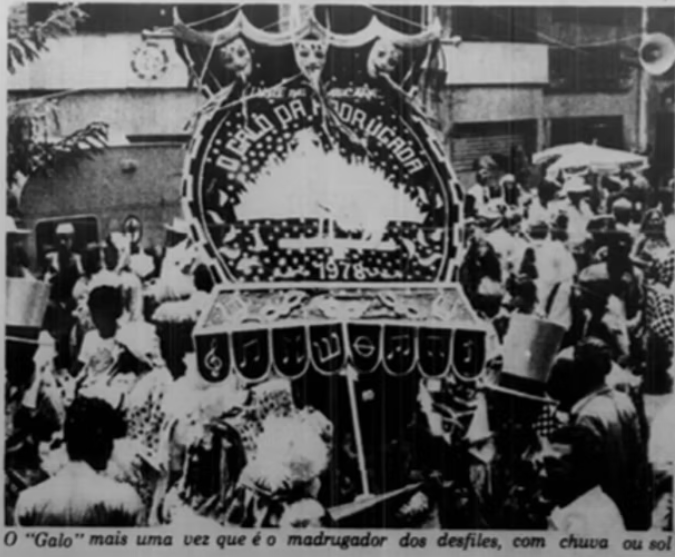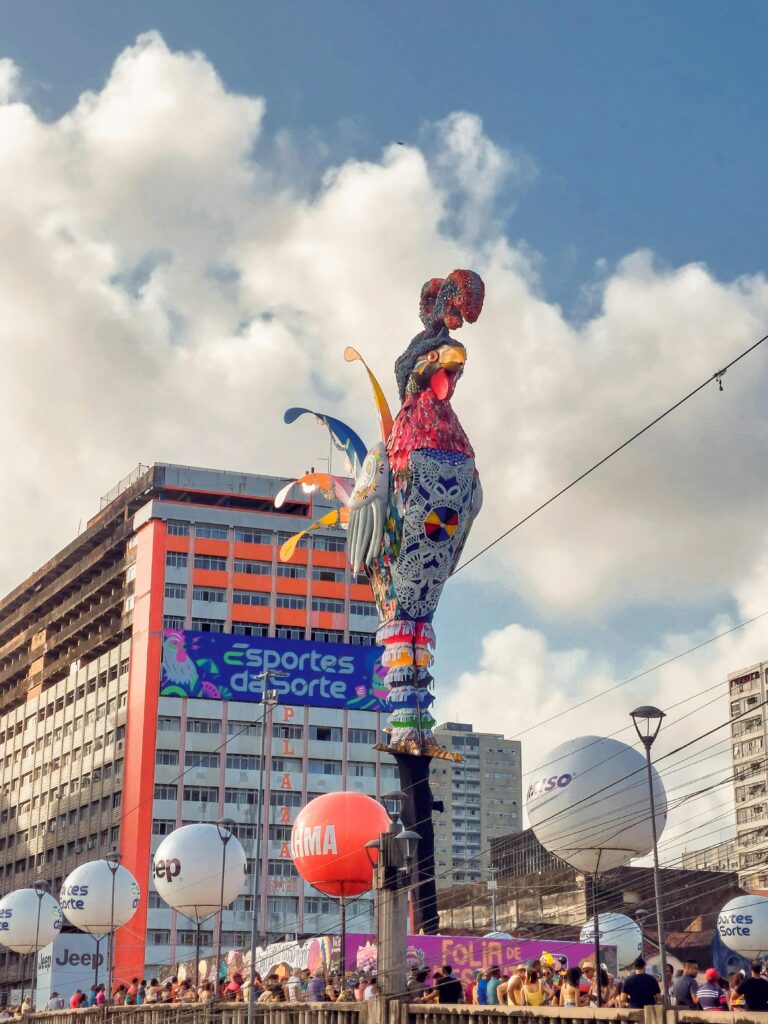

The trajectory of Galo da Madrugada is intrinsically linked to the evolution of frevo, an iconic musical genre of the Pernambuco Carnival. Frevo is a lively, fast-paced music and dance style that originated in the state of Pernambuco, located in the northeastern region of Brazil. Pernambuco is famous for its rich cultural traditions, including its vibrant Carnival celebrations, and is known as the birthplace of frevo. More than just a carnival block, Galo da Madrugada has become a true symbol of Pernambuco’s culture.
Founded in 1978, it began as a modest group of revelers and, over the years, grew into the largest carnival block in the world, recognized by the Guinness Book. Today, at 47 years old, Galo da Madrugada reflects the transformations not only in its organizational dynamics but also in the very music it represents.
Cisneiro Soares de Andrade, musician, ethnomusicologist, one of the founders of the block, and author of the book Galo da Madrugada: Changes in the 30 Years of the Club’s Existence, offers us an insightful perspective on the club’s history, the evolution of frevo, and how these transformations are perceived in the current scene.
“The name of the block came from the tradition of morning gatherings in the São José neighborhood, where revelers would have coffee before taking to the streets. The Galo (rooster) comes from the idea of waking up the city with frevo,” explains Cisneiro.
“The idea to create Galo da Madrugada arose on January 24, 1978, at 43 Padre Floriano Street, in the São José neighborhood, with the goal of reviving the old Carnavals. A group of families from the neighborhood, concerned with the birthplace of frevo and its traditions, decided to found the club, and on Carnival Saturday, they took to the streets masked and dressed in costumes. It was on Zé-Pereira Saturday, on January 28, 1978, that it gathered just over 75 people, including the orchestra musicians, for its first official parade.” – Excerpt from the book Galo da Madrugada: Changes in the 30 Years of the Club’s Existence
The Brazilian Fervor – Long Live Our Frevo!
The dance of Frevo is recognized as Intangible Cultural Heritage of Humanity by UNESCO. However, the name as we know it today emerged in 1906, a period when the police began to ban the practice of capoeira, an Afro-Brazilian martial art. To evade police oversight, capoeiristas began camouflaging their movements, creating a choreography that, from a distance, appeared as a large bubbling, effervescence, and boiling — all derived from the word ferver (to boil).
Frevo also unfolds into different styles, including:
Frevo de Rua (Street Frevo) – Energetic and purely instrumental, this style captures the lively spirit of Carnival in the streets.
Frevo Canção (Frevo Song) – With lyrics that narrate the joy of the festivities and the identity of Pernambuco, this style paved the way for artists like Alceu Valença and Moraes Moreira to incorporate Frevo into their music.
Frevo de Bloco (Block Frevo) – More melodic and lyrical, often accompanied by string and percussion instruments, it evokes the traditional serenades and lyrical blocks of old.
Frevo Eletrizado (Electrified Frevo) – The fusion of Frevo with modernity. Incorporated into the electric trios in the 1980s, it gained distorted guitars and synthesizers, making it more accessible to new generations.
The Sonic Evolution of Frevo in Galo da Madrugada: From Orchestra to Electric Trio
In the early years, the parade was purely instrumental, led by traditional Frevo orchestras. “Back then, it was much more organic. The musicians were in the middle of the crowd, playing without the intermediary of electric trios. I also remember that the revelers of that time seemed to have a much closer connection to the club and its musicians, perhaps because the street Carnival was literally ‘in the street’, and not in the electric trios as it happens today. We walked through the narrow streets of the São José neighborhood, where people squeezed onto the sidewalks and alleys. The revelers showed great care for the orchestra, which could not stop at any moment,” recalls Cisneiro.
As the years went by, the exponential growth of the bloc required logistical and sonic adaptations. To accommodate the increasingly larger crowd, the route was expanded, and in 1983, the electric trios were incorporated. Leaving the narrow streets of the São José neighborhood, this change ensured that the music could reach the entire audience. Additionally, the transition brought significant advantages, such as preserving the energy of the musicians and amplifying the sound.



Cisneiro adds: “Frevo did not get lost with the transition to electric trios, it was adapted to the new times, mainly due to space and sound power considerations. Before, to reach the entire crowd, a large number of musicians was needed to ensure a strong sound mass. With the introduction of electric trios and their amplified sound, this need diminished, also reducing the number of musicians within the trios. Over time, Galo grew so much that it started attracting artists from outside the region, including names from the Southeast. I even remember when Chacrinha came to participate in Galo’s Carnival. By this time, the bloc had already become a consolidated tradition in the Pernambuco Carnival calendar, and this popularity naturally altered the configuration of the parade over the years.”
However, this change also altered the instrumentation. While orchestras were once composed of full sections of brass and percussion, today, many trios work with smaller formations and electronic elements, such as plugged-in guitars and basses.
Even with these transformations, Cisneiro emphasizes that frevo remains the essence of Galo. “The repertoire of Galo da Madrugada continues to be essentially frevo, but its execution has evolved over the years. With the bloc’s growth and the introduction of electric trios, the instrumentation needed to adapt, incorporating guitars, basses, and keyboards to ensure the sound reached the entire crowd,” he says. The mix of instruments and sound elements reflects not only structural changes in the bloc but also an adaptation to the new cultural and technological reality of Carnival.
However, this change also altered the instrumentation. While orchestras were once composed of full sections of brass and percussion, today, many trios work with smaller formations and electronic elements, such as plugged-in guitars and basses.
Even with these transformations, Cisneiro emphasizes that frevo remains the essence of Galo. “The repertoire of Galo da Madrugada continues to be essentially frevo, but its execution has evolved over the years. With the growth of the bloc and the introduction of electric trios, the instrumentation needed to adapt, incorporating guitars, basses, and keyboards to ensure that the sound reached the entire crowd,” he says. The blend of instruments and sound elements reflects not only structural changes in the bloc but also an adaptation to the new cultural and technological reality of Carnival.
Another point addressed by the researcher is the importance of ethnomusicology in understanding these changes. “Research helps us understand how a cultural manifestation adapts to time without losing its identity,” he emphasizes.
Galo da Madrugada has a profound impact not only on music but also on the economy of the São José neighborhood in Recife during Carnival. Recognized as the birthplace of Pernambuco’s frevo, São José played a crucial role in the development of this musical genre, which became established throughout the 19th and early 20th centuries. During this period, the neighborhood was a vibrant meeting point for musicians and artists immersed in the popular cultural manifestations of Pernambuco.
Frevo, with its roots in African, Portuguese, and Indigenous influences, gained strength as a genuine expression of Pernambuco’s Carnival right there in São José. It was in this context that many of the first carnival blocks emerged, which helped shape frevo as we know it today.

Cultural and Social Impact
Today, Carnival drives the region’s economy, bringing investments and an intense commercial flow. However, a study conducted by Cisneiro Soares de Andrade with residents of the neighborhood reveals a recurring concern: the lack of continuity in improvements throughout the year, indicating that the positive impact of Galo is not fully leveraged outside the Carnival season.
Despite this lack of constant attention to the neighborhood that gave rise to the largest carnival block in the world, the relevance of Galo da Madrugada extends beyond Carnival. The institution maintains an active agenda of social and educational actions throughout the year, such as music workshops and frevo-focused festivals, which play a crucial role in preserving local culture and training new generations of musicians and revelers. These initiatives ensure that frevo continues to pulse with vigor, paving the way for the tradition to remain alive and relevant.
Ethnomusicology plays a key role in this process, analyzing the transformations of Galo da Madrugada and preserving the essential elements of the block’s identity. With more than 30 years of changes, Galo da Madrugada continues to echo through the streets of Recife with its contagious energy. Whether in the historic alleys of São José or the contemporary electric trios, one thing is certain: as long as there is Carnival, Galo will keep singing.